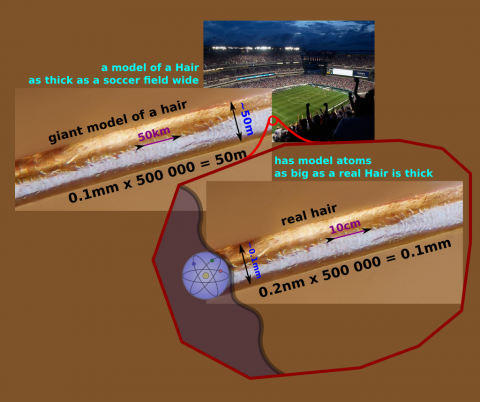Difference between revisions of "Intuitive feel"
(brownian motion in nanorobotics - rudimentary added) |
(intro text & falling experiment quiz image) |
||
| Line 1: | Line 1: | ||
| + | |||
| + | This is an introduction to the character of robotic work in the nanocosm. <br> | ||
| + | It should deliver some intuitive feeling of how things work down there. | ||
| + | |||
[[File:Atom hair soccer en 3.png|thumb|480px|Pluck yourself a Hair and look at it. Imagine a magnified model of the torn of end was built. Would be interesting – wouldn't it? This model was buried halfway such that it runs vertically into ground at the sidelines and that it reaches twentyfive meters of dome-hight at the center of the playfield. When you stand on this soccer field in front of the fractured surface and you hold a real hair against tremendous model then you see: The model-atoms of the giant hair have the diameter of a real hair.]] | [[File:Atom hair soccer en 3.png|thumb|480px|Pluck yourself a Hair and look at it. Imagine a magnified model of the torn of end was built. Would be interesting – wouldn't it? This model was buried halfway such that it runs vertically into ground at the sidelines and that it reaches twentyfive meters of dome-hight at the center of the playfield. When you stand on this soccer field in front of the fractured surface and you hold a real hair against tremendous model then you see: The model-atoms of the giant hair have the diameter of a real hair.]] | ||
| + | |||
| + | __TOC__ | ||
= How big is an atom? = | = How big is an atom? = | ||
| − | Atoms are small but not ridiculously small. | + | Atoms are quite small but they are not as ridiculously small as people usually say. |
If a hair (0.1mm) would be the width of a soccer field (~60m) an atom would be roughly the size of a hair. | If a hair (0.1mm) would be the width of a soccer field (~60m) an atom would be roughly the size of a hair. | ||
Carbon is about 0.2nm or 2Å in size that makes roughly five atoms per nanometer. | Carbon is about 0.2nm or 2Å in size that makes roughly five atoms per nanometer. | ||
| Line 12: | Line 18: | ||
['''Todo:''' add existing image] | ['''Todo:''' add existing image] | ||
| + | |||
| + | = What happens when you let go of a building block? = | ||
| + | |||
| + | [[File:Fall-experiment-quiz-en.svg|thumb|center|480px|A fall experiment quiz to illustrate the quite unfamiliar mechanical behavior in the nanoscale.]] | ||
= Scaling laws = | = Scaling laws = | ||
Revision as of 16:12, 2 January 2016
This is an introduction to the character of robotic work in the nanocosm.
It should deliver some intuitive feeling of how things work down there.

Contents
How big is an atom?
Atoms are quite small but they are not as ridiculously small as people usually say. If a hair (0.1mm) would be the width of a soccer field (~60m) an atom would be roughly the size of a hair. Carbon is about 0.2nm or 2Å in size that makes roughly five atoms per nanometer. When hierarchically building up building structures one can quickly fill up this size gap.
Just for comparison: Relative distances in the other (astronomic) direction are vastly greater. If the planetary orbit of our outermost planet Neptune (which can technically be reached in years) where the size of a hair the nearest stars would lie beyond ~1km and the milkiway would be ~1000km thick at our location. The next galaxies would start at the diameter of our sun ~1000000km then still follows the unimaginable size of intergalactic voids, the observable universe and the universe extrapolated to our "now" of which we now little by now.
[Todo: add existing image]
What happens when you let go of a building block?
Scaling laws
They describe what changes when one goes down the scale. E.g. that magnetic motors become weak but electrostatic ones strong. More details can be found at the scaling laws main page.
The feel of AP Products
AP products though robotic and gemstone like in the nanocosm are not necessarily cold hard and robot like to the human senses. Emulated elasticity can create any form imaginable with gradients from soft to hard. It isn't an easy to attain property but it is an highly desirable one and will emerge at some point.
Bonding energies - Tensile strengths - Stiffnesses
[Todo: Add table - make it visualizable for covalent bonds and VdW bonds]
[Todo: show surface area thats VdW ashesion is energetically equivalent to one covalent bond - related: Form locking]
Brownian motion in nanorobotics
- Envelope of throwing trajectories with same speed
- Throwing trajectories with various speed in same direction
Further
- acceleration limits
- jumping building blocks
